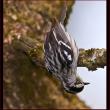Whose habitat?
We’ve been thinking lately about the idea of habitat.
Maybe because the recent onslaught of winter storms has left most of us confined to the small habitat inside and near our homes. Birders often use the term “habitat” as they describe where a certain species of bird is typically found.
For example, we would say that black-throated green warblers nest in forested habitats with lots of coniferous trees and that song sparrows prefer brushy, non-forested habitats.
Some species are even more specific, like the pine warbler that rarely is found away from a pine tree during its summer breeding season.
But if we delve into the question of what habitats birds occur in and why, the complexities of what exactly we mean when we say “habitat” quickly become apparent. Most birds use completely different habitats across the seasons.
Even when they have a staked out breeding territory in summer, they use different components of the habitat within their territory in different ways. Sometimes males and females use the habitat differently.
In the oak and maple dominated woodlands in much of Maine, you can commonly find a number of species of warblers including the black-and-white warbler, the American redstart, and the ovenbird. Each uses the habitat in a different way. The black-and-white warbler creeps along the trunk and branches of the tree as it searches for food.
The American redstart darts about, fanning its tail and snatching insects quickly from the air and off the surfaces of leaves and bark.
The ovenbird uses its oversized feet to walk around on the ground, flipping leaves and probing in nooks and crannies. Each species nests in a different location within the habitat as well. The ovenbird builds its covered nest on the ground, covered with dry leaves forming what looks like a tiny Dutch oven, hence its name.
The American redstart builds an open cup nest in the fork of a low branch of a small tree or shrub while the black-and-white warbler builds its open cup nest on or near the ground at the base of a tree or stump.
One of the classic ecological studies looking at how a community of birds used the same habitat in different ways was carried out in part right on the Maine coast on Mount Desert Island in the 1950s.
Ecologist Robert MacArthur studied warblers that preferred coniferous woodland habitats and found that black-throated green warblers tended to forage in the mid to high sections of the trees, yellow-rumped warblers tended to forage in the lower sections of the trees, and blackburnian warblers almost always in the highest parts of the trees.
Scientists have tried to develop ways to predict whether a species will be in a particular area based on information on the types and density of vegetation and other features as a way to help make decisions on land use and to manage bird populations.
Understanding the features of habitat that birds require and that attract them to a particular spot is often critical when conservationists are trying to restore habitat to increase bird populations.
Wetland restoration is one major area of habitat based conservation work that attempts to make up for the fact that perhaps as many as half of original wetlands have been lost in the U.S. over the last few hundred years.
For the time being, we are enjoying the “habitat” provided by the top of our composter, and watching as a dozen or so different species use it for the same purpose: feeding on the seeds we put out to give them some respite during these particularly snowy days!
Event Date
Address
United States
























